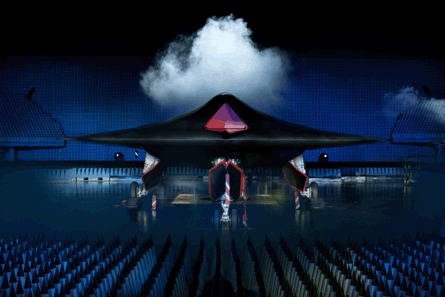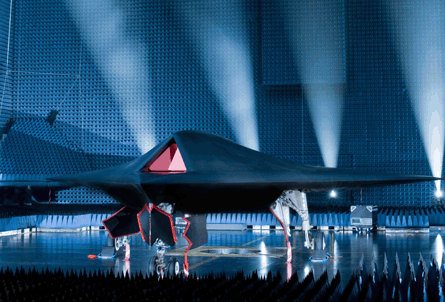The possible future direction of the UK's defence aerospace industry was highlighted on the eve of the show, when the nation's Taranis unmanned combat air system technology demonstrator was revealed.
Representing the pinnacle of British technological know-how, the stealthy design was unveiled on 12 July during a secretive ceremony held at BAE Systems' Warton site in Lancashire. Against a backdrop of strobe lighting, dry ice and to pounding music, Taranis was revealed inside a massive anechoic chamber, ordinarily used to support the company's electronic warfare and stealth test activities.
The result of a more than £144 million ($221 million) project involving the UK Ministry of Defence and an industry team including BAE, GE Aviation, Qinetiq and Rolls-Royce, plus more than 100 suppliers, Taranis - named after the Celtic God of Thunder - has so far taken more than one million man hours of work to create.
 |
|---|
© Crown Copyright |
Launched in December 2006, the programme is intended to prove the UK's ability to produce a stealthy UCAS while maintaining sovereign capability over its technologies and mission equipment.
"We have no dependencies on others beyond the UK," says Nigel Whitehead, group managing director of BAE's Programmes and Support operating unit. The company serves as prime contractor for the work, reporting to the Defence Equipment and Support organisation's UAS project team in Bristol.
Roughly 12m (39ft) long and with a 10m wingspan, the air vehicle is due to undergo flight tests outside the UK during 2011. BAE declines to say where the campaign will be performed, but the majority of its previous unmanned air vehicles have been tested at the Woomera range in South Australia.
Originally valued at £124 million, the Taranis programme has been expanded by £20 million and around one year to incorporate additional test work, such as "to provide further outputs with wider exploitation into manned fast jet aircraft," Team Taranis says. The MoD is providing 75% of the funds required for the effort, with the project's key industry stakeholders allocating the rest.
Before facing the demands of flying such an autonomous system, the members of Team Taranis have first had to overcome what Whitehead describes as "significant challenges" encountered since contract award less than four years ago.
He identifies the air vehicle's tail-less design configuration as having been an issue for BAE's aerodynamics team, "particularly with the active stability air vehicle control". The concealed installation of its R-R/Turbomeca Adour 951 turbofan engine, sourced from BAE's Hawk 128 advanced jet trainer programme, also resulted in "significant issues around the integration of the powerplant to make it invisible, both to the eye and in electrical emissions", he adds.
The integration of further aircraft systems also posed a challenge, due to the relatively small size of the demonstrator, while another was created by having to meet the precision manufacturing demands of assembling an airframe using low-observable materials. With design tolerances having been set at fractions of the width of a human hair, Whitehead says bringing to bear BAE's final assembly skills, honed on manned products such as the Eurofighter Typhoon, was also a tough requirement.
"A number of these technologies have been looked at before, but not all brought together in one platform," he notes.
Aircraft power on was achieved in February 2009, and the system has subsequently undergone ground testing, including of its electrical subsystem equipment, supplied by GE Aviation. These have proved successful, and also demonstrated the availability of the "power-headroom" required to make future adjustments, the industry team says.
Under current plans the demonstrator will have a simulated weapons delivery capability, and be operated under a representative mission profile, ranging from sensing a target to providing battle damage assessment after a strike has been launched. "This is a chosen configuration to demonstrate the technologies; not the specific range and payload," Whitehead says.
However, he notes: "We would like to have some weapons involvement in the future. It's always good to have the wind going past your bomb bays." Some windtunnel testing has already been conducted in support of such a development.
Next year's flight-test campaign is intended to gather data in support of future investment decisions, but any future purchase hinges on the outcome of the UK government's Strategic Defence and Security Review, which will conclude around October. To outline the nation's military equipment priorities for the next 10-15 years, the process will include an assessment of the possible future mix between manned and unmanned combat aircraft to be operated by the Royal Air Force.
In parallel, consideration is also being given to the possibility of pursuing systems such as new unmanned surveillance aircraft or even UCAS in collaboration with allied nations such as France or Italy. Several other European nations, including Germany and Sweden, have already invested in research and development activities linked to a future offensive air vehicle, but the continent's military operators have so far failed to come up with a strategy to purchase such equipment for frontline use.
 |
|---|
© Crown Copyright |
Air Chief Marshal Simon Bryant, commander-in-chief of the RAF's Air Command organisation, says a future UCAS could meet three of the service's key operating needs: control of the air, attack and intelligence/situational awareness. Such a system's autonomy and survivability would offer a heightened ability to hold an adversary at threat of attack, he says.
However, the air force sees an enduring and "essential requirement for human intervention" in such operations, Bryant adds, referring to the need to keep a "highly trained, air-minded individual" in the decision-making loop before any offensive action is initiated.
Whitehead believes that a production-standard UCAS could potentially be available for UK use from around 2018-20, and reveals that Team Taranis is already looking at spiral development options in the event that a firm requirement emerges.
Speaking at the Warton event, minister for international security strategy Gerald Howarth described the Taranis programme as "a new benchmark between the MoD and the defence industrial base", and praised the partnership for its "agile thinking" throughout challenging times. "The project remains on track to deliver on all its objectives, and the trials will unequivocally demonstrate UK expertise on the world stage," he says.
A vocal advocate for the aerospace industry and with Farnborough in his constituency, Howarth says the SDSR process will be "policy-led and resource-informed". However, he says key questions have yet to be answered on issues such as "how far are we desirous of maintaining sovereign capability in the UK".
The long-term importance of the Taranis project is not lost on BAE. Describing the effort as "key to sustaining the UK military aircraft sector", Whitehead says the programme has already shown "an outstanding example of British technical capability".
"This aircraft is a prelude to the next generation of fighting capability," he says. "If we didn't play a part then there would be no future for the UK aerospace industry."
Rolls-Royce is also convinced about the benefits of the demonstration. "This is a vital programme for all the team members," says Simon Henley, new product director for its Defence Aerospace business unit. "It has allowed us to learn about the world beyond manned combat aircraft." The effort also holds great potential to attract the engineers of the future to seek a career in the aerospace sector, he adds.
BAE has so far invested more than £100 million of its own money in the pursuit of technologies linked to unmanned systems, including considerable research to date into aircraft autonomy, both from its UK and Australian business concerns.
The company's previous work has included flying unmanned demonstrators including the Raven, Corax and most recently the Mantis; a medium-altitude, long-endurance aircraft also being offered to meet the future requirements of the UK MoD. Recently returned to Warton after completing a successful flight test campaign at Woomera, the autonomous Mantis design will be on show at Farnborough, represented by a full-scale model.
"History teaches us that those who invest in technologies learn the lessons needed for a future industrial role," Whitehead concludes. "Taranis should be no different."
Source: Flight Daily News























